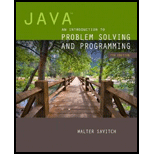
Java: An Introduction to Problem Solving and Programming plus MyProgrammingLab with Pearson eText -- Access Card Package (7th Edition)
7th Edition
ISBN: 9780133862119
Author: Walter Savitch
Publisher: PEARSON
expand_more
expand_more
format_list_bulleted
Expert Solution & Answer
Chapter 12.3, Problem 22STQ
Explanation of Solution
Inner class in Java:
- Inner class is a class which is defined within other classes. User can easily understand this class.
- Defining an inner class is very simple that one should include the definition of the inner class within another class.
Example:
The example of inner class is given below:
/* Define "sampleLinkedList" class */
public class sampleLinkedList
{
private ListNode head;
/* Method definition of "sampleLinkedList" is inserted here...
Expert Solution & Answer
Want to see the full answer?
Check out a sample textbook solution
Students have asked these similar questions
Using R language
using r language
using r language
Chapter 12 Solutions
Java: An Introduction to Problem Solving and Programming plus MyProgrammingLab with Pearson eText -- Access Card Package (7th Edition)
Ch. 12.1 - Suppose aList is an object of the class...Ch. 12.1 - Prob. 2STQCh. 12.1 - Prob. 3STQCh. 12.1 - Prob. 4STQCh. 12.1 - Can you use the method add to insert an element at...Ch. 12.1 - Prob. 6STQCh. 12.1 - Prob. 7STQCh. 12.1 - If you create a list using the statement...Ch. 12.1 - Prob. 9STQCh. 12.1 - Prob. 11STQ
Ch. 12.1 - Prob. 12STQCh. 12.2 - Prob. 13STQCh. 12.2 - Prob. 14STQCh. 12.2 - Prob. 15STQCh. 12.2 - Prob. 16STQCh. 12.3 - Prob. 17STQCh. 12.3 - Prob. 18STQCh. 12.3 - Prob. 19STQCh. 12.3 - Write a definition of a method isEmpty for the...Ch. 12.3 - Prob. 21STQCh. 12.3 - Prob. 22STQCh. 12.3 - Prob. 23STQCh. 12.3 - Prob. 24STQCh. 12.3 - Redefine the method getDataAtCurrent in...Ch. 12.3 - Repeat Question 25 for the method...Ch. 12.3 - Repeat Question 25 for the method...Ch. 12.3 - Repeat Question 25 for the method...Ch. 12.4 - Revise the definition of the class ListNode in...Ch. 12.4 - Prob. 30STQCh. 12 - Repeat Exercise 2 in Chapter 7, but use an...Ch. 12 - Prob. 2ECh. 12 - Prob. 3ECh. 12 - Repeat Exercises 6 and 7 in Chapter 7, but use an...Ch. 12 - Write a static method removeDuplicates...Ch. 12 - Write a static method...Ch. 12 - Write a program that will read sentences from a...Ch. 12 - Repeat Exercise 12 in Chapter 7, but use an...Ch. 12 - Write a program that will read a text file that...Ch. 12 - Revise the class StringLinkedList in Listing 12.5...Ch. 12 - Prob. 12ECh. 12 - Write some code that will use an iterator to...Ch. 12 - Prob. 14ECh. 12 - Write some code that will use an iterator to...Ch. 12 - Prob. 17ECh. 12 - Revise the method selectionSort within the class...Ch. 12 - Repeat the previous practice program, but instead...Ch. 12 - Repeat Practice Program 1, but instead write a...Ch. 12 - Write a program that allows the user to enter an...Ch. 12 - Write a program that uses a HashMap to compute a...Ch. 12 - Write a program that creates Pet objects from data...Ch. 12 - Repeat the previous programming project, but sort...Ch. 12 - Repeat the previous programming project, but read...Ch. 12 - Prob. 9PPCh. 12 - Prob. 10PPCh. 12 - Prob. 11PPCh. 12 - Prob. 12PPCh. 12 - Prob. 13PPCh. 12 - Prob. 14PPCh. 12 - Prob. 15PP
Knowledge Booster
Similar questions
- I need help in explaining how I can demonstrate how the Laplace & Inverse transformations behaves in MATLAB transformation (ex: LIke in graph or something else)arrow_forwardYou have made the Web solution with Node.js. please let me know what problems and benefits I would experience while making the Web solution here, as compared to any other Web solution you have developed in the past. what problems and benefits/things to keep in mind as someone just learningarrow_forwardPHP is the server-side scripting language. MySQL is used with PHP to store all the data. EXPLAIN in details how to install and run the PHP/MySQL on your computer. List the issues and challenges I may encounter while making this set-up? why I asked: I currently have issues logging into http://localhost/phpmyadmin/ and I tried using the command prompt in administrator to reset the password but I got the error LOCALHOST PORT not found.arrow_forward
arrow_back_ios
SEE MORE QUESTIONS
arrow_forward_ios
Recommended textbooks for you
 Programming with Microsoft Visual Basic 2017Computer ScienceISBN:9781337102124Author:Diane ZakPublisher:Cengage Learning
Programming with Microsoft Visual Basic 2017Computer ScienceISBN:9781337102124Author:Diane ZakPublisher:Cengage Learning C++ for Engineers and ScientistsComputer ScienceISBN:9781133187844Author:Bronson, Gary J.Publisher:Course Technology Ptr
C++ for Engineers and ScientistsComputer ScienceISBN:9781133187844Author:Bronson, Gary J.Publisher:Course Technology Ptr Principles of Information Systems (MindTap Course...Computer ScienceISBN:9781285867168Author:Ralph Stair, George ReynoldsPublisher:Cengage Learning
Principles of Information Systems (MindTap Course...Computer ScienceISBN:9781285867168Author:Ralph Stair, George ReynoldsPublisher:Cengage Learning Management Of Information SecurityComputer ScienceISBN:9781337405713Author:WHITMAN, Michael.Publisher:Cengage Learning,Programming Logic & Design ComprehensiveComputer ScienceISBN:9781337669405Author:FARRELLPublisher:Cengage
Management Of Information SecurityComputer ScienceISBN:9781337405713Author:WHITMAN, Michael.Publisher:Cengage Learning,Programming Logic & Design ComprehensiveComputer ScienceISBN:9781337669405Author:FARRELLPublisher:Cengage Principles of Information Systems (MindTap Course...Computer ScienceISBN:9781305971776Author:Ralph Stair, George ReynoldsPublisher:Cengage Learning
Principles of Information Systems (MindTap Course...Computer ScienceISBN:9781305971776Author:Ralph Stair, George ReynoldsPublisher:Cengage Learning

Programming with Microsoft Visual Basic 2017
Computer Science
ISBN:9781337102124
Author:Diane Zak
Publisher:Cengage Learning

C++ for Engineers and Scientists
Computer Science
ISBN:9781133187844
Author:Bronson, Gary J.
Publisher:Course Technology Ptr

Principles of Information Systems (MindTap Course...
Computer Science
ISBN:9781285867168
Author:Ralph Stair, George Reynolds
Publisher:Cengage Learning

Management Of Information Security
Computer Science
ISBN:9781337405713
Author:WHITMAN, Michael.
Publisher:Cengage Learning,

Programming Logic & Design Comprehensive
Computer Science
ISBN:9781337669405
Author:FARRELL
Publisher:Cengage

Principles of Information Systems (MindTap Course...
Computer Science
ISBN:9781305971776
Author:Ralph Stair, George Reynolds
Publisher:Cengage Learning